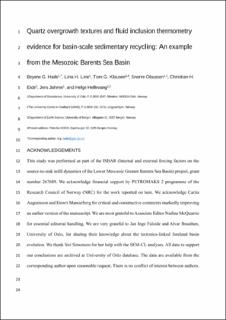| dc.description.abstract | Sedimentary recycling has the potential to obscure source-to-sink relationships, provenance interpretations, burial history reconstructions and robust reservoir quality predictions in siliciclastic sedimentary basins. Here, we integrate petrographic and cathodoluminescence microtextures with fluid inclusion thermometry in quartz overgrowths to identify sedimentary recycling and to constrain the potential provenance candidate for recycled grains in Lower Mesozoic sandstone of the western Barents Sea basin. Four diagenetic imprints were recognized as proof of sediment recycling: (a) microtextural surface properties of overgrowths, (b) the presence of overgrowths at sutured grain contacts, (c) reversed diagenetic sequences and (d) fluid inclusions within quartz overgrowths. The diagenetic imprints confirm delivery of recycled sediments across the western Barents Sea basin. Their widespread distribution across the basin suggest that the recycled grains were derived from a drainage basin with regional-scale sediment dispersal potential during the latest Triassic. Furthermore, the drainage basin must have contained sedimentary rocks. Prior to surface exposure, the precursor sedimentary basin was subjected to burial temperatures exceeding 130°C, whereby syntaxial quartz overgrowths precipitated. This temperature indicates an uplift of around 3–4 km, which represents a significant tectonic event. Recycled quartz grains can provide insights on their provenance as they retain direct temperature records. The geothermal signatures and geographically widespread distribution of recycled quartz exclude spatially restricted intrabasinal highs and higher-temperature crystalline rocks as provenance candidates for the recycled grain portion. Our data support the contemporaneous Novaya Zemlya Fold and Thrust Belt as the most likely provenance candidate in the region. The integrated approach demonstrated herein can be used to constrain sediment recycling and partly eroded provenance candidates in sedimentary basins of equivalent setting worldwide, particularly in quartz-rich strata susceptible to sediment supply from older uplifted sedimentary basins. | en_US |
